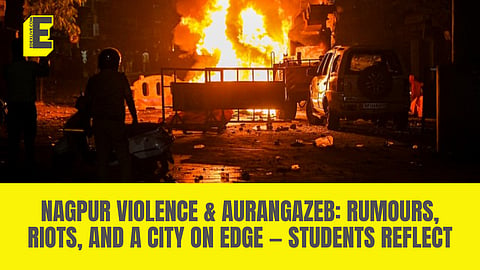

What started as a protest demanding the removal of Mughal emperor Aurangzeb’s tomb turned into one of the most violent riots the city has seen in a century.
Unverified rumours of religious desecration spread like wildfire on social media, fueling tensions between communities and leading to large-scale destruction, arson, and injuries, including to police personnel.
A protest turns violent
The day began with what seemed to be a routine demonstration. Around noon, workers from the Vishwa Hindu Parishad (VHP) and Bajrang Dal staged a protest in the Mahal area, burning an effigy of Aurangzeb.
Shortly after, unconfirmed reports claimed that religious content had been set on fire. Videos spread rapidly on social media, sparking outrage.
By the evening, thousands gathered on the streets, leading to stone-pelting, arson, and violent clashes with law enforcement.
Nearly 30 police officers were injured, several vehicles were torched, and prohibitory orders under Section 144 were imposed.
Maharashtra Chief Minister Devendra Fadnavis called the violence a "planned incident" and warned of strict action against those responsible. “Specific houses and establishments were targeted, it looks like a conspiracy,” he stated in the state Legislative Assembly.
Students speak up
For many students, the events were shocking and incomprehensible. Avantika, a student from Nagpur, pointed to the recent release of the movie Chhava as a trigger for the tensions.
“These fights have been happening since the movie came out, but they were never this big,” she said.
“This escalated on March 17 when an FIR (First Information Report) was filed, but no action was taken. That’s when rumours started spreading that the Quran was burnt. Everyone from both communities knew it was just a rumour, yet violence broke out, leaving people terrified and property destroyed,” she shared with EdexLive.
She questioned the very premise of the riots. “The tomb is not even in Nagpur, so why are people fighting here? People in Aurangabad, where it actually exists, aren’t fighting over it, so why are we?” she asked and added, “This city is known for its peaceful coexistence. Who suffered? Innocent people whose property was destroyed for something that has nothing to do with their lives today.”
For students like Saurabh Singh, the violence has instilled deep fear. “I study here, and my parents are worried. Even though schools and colleges are open, my relatives have advised me not to step out,” he said.
“I went to pick up a parcel, but I was told it would be handed over in another area because movement is still restricted. Even auto drivers are hesitant to go to the affected areas. Shops are shut, and people are scared that something might happen again,” he opined.
Legal action and police response
A local court has sent 19 people accused in the Nagpur violence to police custody till March 21. The police produced them before the court on Tuesday, March 18, according to a report by PTI.
So far, around 50 people have been arrested for stone-pelting and arson in the city on Monday night, March 17. A senior police officer said the situation is now under control.
Police Commissioner Ravinder Kumar Singal stated that they will review the situation today, Wednesday afternoon, March 19.
To maintain peace, about 2,000 police personnel have been deployed in sensitive areas. Special police teams are patrolling under the command of a senior officer. The city police have announced a curfew in several areas, including Kotwali, Ganeshpeth, Tehsil, Lakadganj, Pachpaoli, Shanti Nagar, Sakkardara, Nandanvan, Imambada, Yashodhara Nagar, and Kapil Nagar.
Was this pre-planned?
Saurabh raised suspicions about the targeting of properties. “It seemed planned. Usually, everyone parks in the common area, but on the day of the riots, only vehicles from one community were left there — and those were the ones burnt. How is that possible?” he questioned.
“Nagpur has not seen a riot like this in nearly a hundred years. This is not what our city stands for,” he affirmed.
Abhiram, a resident of the riot-affected area, strongly believes that the violence was orchestrated. “The rumour that Quranic verses were burnt started the chaos, but the protest itself was peaceful. Even the police investigated and found nothing of the sort had happened,” he said and added, “But by 7 pm, a tractor full of weapons, stones, bombs, and even gunpowder entered the Mahal area. How is that not pre-planned?”
Abhiram claimed that Hindu residents were the ones who suffered the most.
“People who had nothing to do with this lost their homes and vehicles. I personally heard rioters chanting anti-India slogans. Stone-pelting went on all night,” he said. “When police verified that no religious texts were burnt, how did 500 people — who don’t even live in the area — suddenly appear with weapons?” he questioned.
He also defended the self-defence actions taken by residents.
“If a mob of hundreds is attacking your house, won’t you do something to protect your family? There were women and children inside. Police didn’t reach on time, so residents had no choice,” he argued and added, “Look at the pattern — was a single shop or vehicle owned by a Muslim burnt? Only Hindu-owned property was destroyed. How is that not planned?”
A city wounded
While curfew has now been lifted in most parts of the city, fear lingers. Many residents are still reluctant to step out. “Even auto drivers refuse to enter the affected areas,” said Saurabh. The riot-affected areas remain under close police watch, and security has been heightened across sensitive zones.
The larger question remains — why did Nagpur, a city known for its communal harmony, witness such a riot over a tomb that isn’t even within its limits? As investigations continue, what is clear is that misinformation, political narratives, and pre-existing tensions combined to create a storm that left the city scarred, few students say.
For now, Nagpur is picking up the pieces. But will it ever be the same again?
